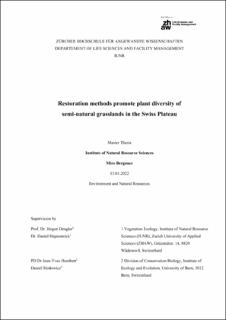Please use this identifier to cite or link to this item:
https://doi.org/10.21256/zhaw-25233Full metadata record
| DC Field | Value | Language |
|---|---|---|
| dc.contributor.advisor | Dengler, Jürgen | - |
| dc.contributor.advisor | Hepenstrick, Daniel | - |
| dc.contributor.advisor | Humbert, Jean-Yves | - |
| dc.contributor.advisor | Slodowicz, Daniel | - |
| dc.contributor.author | Bergauer, Miro | - |
| dc.date.accessioned | 2022-06-30T15:32:46Z | - |
| dc.date.available | 2022-06-30T15:32:46Z | - |
| dc.date.issued | 2022 | - |
| dc.identifier.uri | https://digitalcollection.zhaw.ch/handle/11475/25233 | - |
| dc.description.abstract | Traditionally managed grasslands are well-known biodiversity hotspots in the European cultural landscape. Though, despite continuous extensive management, many show their plant diversity decreasing. The restoration of these degraded grasslands has gained importance in recent years due to the ongoing loss of farmland biodiversity, but remains, nevertheless, a challenge. Many active restoration methods exist ‒ such as reseeding using hay transfer or with a regional natural or commercial seed mixtures ‒ and have been shown to improve plant diversity successfully when applied in combination with soil disturbance. However, the outcome of grassland restoration is difficult to predict as it strongly depends on regional conditions and these methods have not yet been studied Switzerland. In this study, we experimentally tested at the field (i.e., meadow) scale four active restoration methods that included without any seed addition or soil disturbance. This was replicated in 12 regions spread over the Swiss Plateau. Each region was assigned to one species-rich donor meadow where natural seeds and green hay were harvested and distributed on the restoration meadows. All vascular plants and their cover were recorded in two permanent plots (8 m2 each) one year before restoration (in 2018) and two years after restoration (in 2021, restoration occurred in spring 2019). In addition, the number of QII plant indicator species were recorded in a 3-m diameter plot (QII for quality two level, based on the Swiss ecological quality assessment method, see main text for more details). Total species richness of both permanent plots increased by 9 ± 1 species per meadow. Restoration was even more successful when measured in terms of QII plant indicators, with an increase of 5.7 ± 0.4 indicators and higher explained variance estimated by restoration treatment (R2 = 0.57). Meadows restored with SC harboured both the highest plant species richness and the most QII species. Beta diversity, however, was lower in SC than in HP or SN. The HH treatment resulted in a smaller increase in plant species richness than the HP treatment, which was related to less soil disturbance during the restoration process. We tested if some environmental parameters affected the restoration and found that soil phosphate content negatively correlated with species richness. Using community-weighted mean analyses, we found that specific leaf area (SLA) was low in SC and SN. In SN also the month of first flowering was significantly later. The number of seeds and seed mass showed significant differences between treatments and was particularly high in HP whereas seed mass was low in C. These short-term effects (after two years) of grassland restoration are promising but we expect that plant communities will undergo further changes in species composition and plant species richness within the next few years. We recommend that the evaluation is repeated in two and four years. | de_CH |
| dc.format.extent | 30 | de_CH |
| dc.language.iso | en | de_CH |
| dc.publisher | ZHAW Zürcher Hochschule für Angewandte Wissenschaften | de_CH |
| dc.rights | http://creativecommons.org/licenses/by/4.0/ | de_CH |
| dc.subject.ddc | 333.7: Landflächen, Naturerholungsgebiete | de_CH |
| dc.subject.ddc | 580: Pflanzen (Botanik) | de_CH |
| dc.title | Restoration methods promote plant diversity of semi-natural grasslands in the Swiss Plateau | de_CH |
| dc.type | Thesis: Master | de_CH |
| dcterms.type | Text | de_CH |
| zhaw.departement | Life Sciences und Facility Management | de_CH |
| zhaw.publisher.place | Winterthur | de_CH |
| dc.identifier.doi | 10.21256/zhaw-25233 | - |
| zhaw.originated.zhaw | Yes | de_CH |
| Appears in collections: | Masterarbeiten Umwelt und Natürliche Ressourcen | |
Files in This Item:
| File | Description | Size | Format | |
|---|---|---|---|---|
| 2022_Bergauer_Miro_MAS_ENR.pdf | 1.63 MB | Adobe PDF |  View/Open |
Show simple item record
Bergauer, M. (2022). Restoration methods promote plant diversity of semi-natural grasslands in the Swiss Plateau [Master’s thesis, ZHAW Zürcher Hochschule für Angewandte Wissenschaften]. https://doi.org/10.21256/zhaw-25233
Bergauer, M. (2022) Restoration methods promote plant diversity of semi-natural grasslands in the Swiss Plateau. Master’s thesis. ZHAW Zürcher Hochschule für Angewandte Wissenschaften. Available at: https://doi.org/10.21256/zhaw-25233.
M. Bergauer, “Restoration methods promote plant diversity of semi-natural grasslands in the Swiss Plateau,” Master’s thesis, ZHAW Zürcher Hochschule für Angewandte Wissenschaften, Winterthur, 2022. doi: 10.21256/zhaw-25233.
BERGAUER, Miro, 2022. Restoration methods promote plant diversity of semi-natural grasslands in the Swiss Plateau. Master’s thesis. Winterthur: ZHAW Zürcher Hochschule für Angewandte Wissenschaften
Bergauer, Miro. 2022. “Restoration Methods Promote Plant Diversity of Semi-Natural Grasslands in the Swiss Plateau.” Master’s thesis, Winterthur: ZHAW Zürcher Hochschule für Angewandte Wissenschaften. https://doi.org/10.21256/zhaw-25233.
Bergauer, Miro. Restoration Methods Promote Plant Diversity of Semi-Natural Grasslands in the Swiss Plateau. ZHAW Zürcher Hochschule für Angewandte Wissenschaften, 2022, https://doi.org/10.21256/zhaw-25233.
Items in DSpace are protected by copyright, with all rights reserved, unless otherwise indicated.